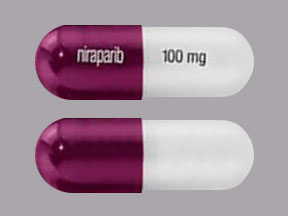Niraparib and Alcohol/Food Interactions
There is 1 alcohol/food/lifestyle interaction with niraparib.
Caffeine Niraparib
Minor Drug Interaction
Coadministration with niraparib may decrease the plasma concentrations of drugs that are substrates of the CYP450 1A2 isoenzyme. At high concentrations, niraparib is able to weakly induce CYP450 1A2. If niraparib is used in combination with substrates of CYP450 1A2, particularly those with a narrow therapeutic range (e.g., clozapine, theophylline, ropinirole), then monitoring for signs and symptoms of reduced exposure to the CYP450 1A2 substrate should be considered.
References (6)
- (2023) "Product Information. Akeega (abiraterone-niraparib)." Janssen Biotech, Inc.
- (2023) "Product Information. Zejula (niraparib)." GlaxoSmithKline
- (2023) "Product Information. Zejula (niraparib)." GlaxoSmithKline Inc
- (2023) "Product Information. Akeega (abiraterone-niraparib)." Janssen Inc
- (2023) "Product Information. Zejula (niraparib)." GlaxoSmithKline Australia Pty Ltd
- (2023) "Product Information. Zejula (niraparib)." GlaxoSmithKline UK Ltd
Switch to consumer interaction data
Niraparib drug interactions
There are 620 drug interactions with niraparib.
Niraparib disease interactions
There are 5 disease interactions with niraparib which include:
More about niraparib
- niraparib consumer information
- Check interactions
- Compare alternatives
- Reviews (63)
- Side effects
- Dosage information
- During pregnancy
- Drug class: PARP inhibitors
- Breastfeeding
- En español
Related treatment guides
Drug Interaction Classification
| Highly clinically significant. Avoid combinations; the risk of the interaction outweighs the benefit. | |
| Moderately clinically significant. Usually avoid combinations; use it only under special circumstances. | |
| Minimally clinically significant. Minimize risk; assess risk and consider an alternative drug, take steps to circumvent the interaction risk and/or institute a monitoring plan. | |
| No interaction information available. |
See also:
Further information
Always consult your healthcare provider to ensure the information displayed on this page applies to your personal circumstances.


